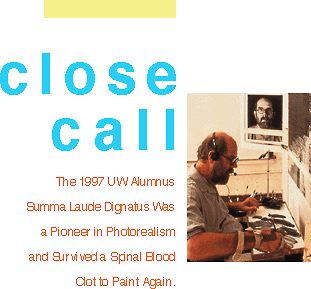 By Jon Marmor
By Jon Marmor
 By Jon Marmor
By Jon Marmor
He was big and clumsy and not very athletic. Because he was dyslexic, everyone considered him dumb and lazy. He was told to forget about college. He couldn't play sports because he couldn't keep up with his friends.
But that wasn't the only pain Chuck Close had to deal with in his young life. His father, a sheet metal worker, plumber and on-the-side inventor, was always in ill health and moved the family from Monroe to Everett to Tacoma to Everett in search of civil service jobs with health benefits.
When Close was 11, his life became pure hell. His father died. His mother, a trained pianist who in the Great Depression gave up her aspirations for concert career, got breast cancer. They lost their home because of medical bills. His grandmother was diagnosed with Parkinson's disease. And Close, an only child, spent most of the year in bed with nephritis, a nasty kidney infection.
One thing did help him cope with the mind-numbing agony, sadness and misery: art.
He always liked to draw. At age 4, he knew he wanted to be an artist. At the age of 5, his dad made him an easel for his birthday and got him a set of oil paints from Sears. In an attempt to win friends and "get kids to be around me," he also did magic and puppet shows. He drew and painted. People noticed.
Little did Charles Thomas Close know back then that he would indeed to go to college, graduating not only from the University of Washington in 1962 (magna cum laude) but from Yale as well. Now, at the age of 57, he is one of the true superstars of art. His works hang in the world's most prestigious museums, he is considered by ARTNews magazine to be one of the 50 most influential people in the art world--and he is so big he turned down a major retrospective at New York's Metropolitan Museum of Art because promises were broken. He chose the Museum of Modern Art instead. No one can recall an artist ever turning down the Met.
But this is much more than just the story of a local boy who made good. On Dec. 7, 1988, at the age of 49, Close was at the height of his career as a portrait painter when he was stricken with a spinal blood clot that left him a quadriplegic. Many thought his career was over.
As he came to grips with life in a motorized wheelchair, unable to move from the neck down, with little hope for improvement, his biggest fear was that "I was not going to make art. Since I'll never be able to move again, I would not be able to make art. I watched my muscles waste. My hands didn't work."
But like the previous tragedies in his life, that didn't stop him either. He not only returned to painting, but with a new style that has kept his place as one of the great American painters of our time. This month he will receive a new honor to add to the mantle of his Manhattan home--he becomes the 1997 UW Alumnus Summa Laude Dignatus, the highest honor an alumnus of the University of Washington can receive.
Finding His Own Voice Through Photorealism
Life as a UW Student: Bald at 20
On the Edge of Death--and Rebirth
Chuck Close's Gallery and Contact Information
Send a letter to the editor at columns@u.washington.edu.